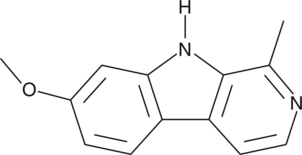Cayman
Showing 23401–23550 of 45550 results
-
Autotaxin converts lysophosphatidylcholine to lysophosphatidic acid (LPA), which can mediate changes in cell proliferation, angiogenesis, and cytokine secretion. HA-155 is a boronic acid-based compound that inhibits autotaxin (IC50 = 5.7 nM) by selectively binding to its catalytic threonine.{19277,28701} It has been shown to dose-dependently block thrombin-induced LPA secretion in platelets.{28702}
Brand:CaymanSKU:11034 - 5 mgAvailable on backorder
Halcinonide is a synthetic glucocorticoid with anti-inflammatory properties.{40483,40484} In a rabbit model of edema, topical application of halcinonide (0.1% w/w) decreases edema by 55% in a reversed passive Arthus skin test (RPA).{40483} Halcinonide (0.1% w/w) inhibits croton oil-induced ear edema by 70.1% and homologous passive cutaneous anaphylaxis (PCA) by 88.0% in rats dosed three hours prior to induction of inflammation.{40484} Application of halcinonide (0.1% w/w) to the abraded surface of cecum in rats inhibits leukocyte adhesion (43.3% incidence versus 100% for controls) and lowers the total number of intraperitoneal leukocytes from 270 million to 121 million 3 days post surgery.{40485} It also acts as an agonist at the smoothened (Smo) receptor with an EC50 value of 1,100 nM.{40486} Formulations containing halcinonide have been used to treat inflammatory and corticosteroid-responsive dermatoses.
Brand:CaymanSKU:23780 - 10 mgAvailable on backorder
Halcinonide is a synthetic glucocorticoid with anti-inflammatory properties.{40483,40484} In a rabbit model of edema, topical application of halcinonide (0.1% w/w) decreases edema by 55% in a reversed passive Arthus skin test (RPA).{40483} Halcinonide (0.1% w/w) inhibits croton oil-induced ear edema by 70.1% and homologous passive cutaneous anaphylaxis (PCA) by 88.0% in rats dosed three hours prior to induction of inflammation.{40484} Application of halcinonide (0.1% w/w) to the abraded surface of cecum in rats inhibits leukocyte adhesion (43.3% incidence versus 100% for controls) and lowers the total number of intraperitoneal leukocytes from 270 million to 121 million 3 days post surgery.{40485} It also acts as an agonist at the smoothened (Smo) receptor with an EC50 value of 1,100 nM.{40486} Formulations containing halcinonide have been used to treat inflammatory and corticosteroid-responsive dermatoses.
Brand:CaymanSKU:23780 - 100 mgAvailable on backorder
Halcinonide is a synthetic glucocorticoid with anti-inflammatory properties.{40483,40484} In a rabbit model of edema, topical application of halcinonide (0.1% w/w) decreases edema by 55% in a reversed passive Arthus skin test (RPA).{40483} Halcinonide (0.1% w/w) inhibits croton oil-induced ear edema by 70.1% and homologous passive cutaneous anaphylaxis (PCA) by 88.0% in rats dosed three hours prior to induction of inflammation.{40484} Application of halcinonide (0.1% w/w) to the abraded surface of cecum in rats inhibits leukocyte adhesion (43.3% incidence versus 100% for controls) and lowers the total number of intraperitoneal leukocytes from 270 million to 121 million 3 days post surgery.{40485} It also acts as an agonist at the smoothened (Smo) receptor with an EC50 value of 1,100 nM.{40486} Formulations containing halcinonide have been used to treat inflammatory and corticosteroid-responsive dermatoses.
Brand:CaymanSKU:23780 - 25 mgAvailable on backorder
Halcinonide is a synthetic glucocorticoid with anti-inflammatory properties.{40483,40484} In a rabbit model of edema, topical application of halcinonide (0.1% w/w) decreases edema by 55% in a reversed passive Arthus skin test (RPA).{40483} Halcinonide (0.1% w/w) inhibits croton oil-induced ear edema by 70.1% and homologous passive cutaneous anaphylaxis (PCA) by 88.0% in rats dosed three hours prior to induction of inflammation.{40484} Application of halcinonide (0.1% w/w) to the abraded surface of cecum in rats inhibits leukocyte adhesion (43.3% incidence versus 100% for controls) and lowers the total number of intraperitoneal leukocytes from 270 million to 121 million 3 days post surgery.{40485} It also acts as an agonist at the smoothened (Smo) receptor with an EC50 value of 1,100 nM.{40486} Formulations containing halcinonide have been used to treat inflammatory and corticosteroid-responsive dermatoses.
Brand:CaymanSKU:23780 - 50 mgAvailable on backorder
Halobetasol propionate is a synthetic glucocorticoid.{41241} It inhibits dermatitis induced by ultraviolet light in guinea pigs (ED50 = 1.45 µg/animal) and by oxazolone in mice (ED50 = 0.8 µg/animal).{36326} Halobetasol propionate also has anti-inflammatory effects on croton oil-induced ear edema in rats (ED50s = 10 µg/ml and 0.5 µg/ear) and mice (ED50s = 1.2 and <0.32 µg/ear after 6 and 24 hours of treatment, respectively). Topical formulations containing halobetasol propionate have been used for inflammatory and pruritic dermatitis.
Brand:CaymanSKU:23781 - 10 mgAvailable on backorder
Halobetasol propionate is a synthetic glucocorticoid.{41241} It inhibits dermatitis induced by ultraviolet light in guinea pigs (ED50 = 1.45 µg/animal) and by oxazolone in mice (ED50 = 0.8 µg/animal).{36326} Halobetasol propionate also has anti-inflammatory effects on croton oil-induced ear edema in rats (ED50s = 10 µg/ml and 0.5 µg/ear) and mice (ED50s = 1.2 and <0.32 µg/ear after 6 and 24 hours of treatment, respectively). Topical formulations containing halobetasol propionate have been used for inflammatory and pruritic dermatitis.
Brand:CaymanSKU:23781 - 25 mgAvailable on backorder
Halobetasol propionate is a synthetic glucocorticoid.{41241} It inhibits dermatitis induced by ultraviolet light in guinea pigs (ED50 = 1.45 µg/animal) and by oxazolone in mice (ED50 = 0.8 µg/animal).{36326} Halobetasol propionate also has anti-inflammatory effects on croton oil-induced ear edema in rats (ED50s = 10 µg/ml and 0.5 µg/ear) and mice (ED50s = 1.2 and <0.32 µg/ear after 6 and 24 hours of treatment, respectively). Topical formulations containing halobetasol propionate have been used for inflammatory and pruritic dermatitis.
Brand:CaymanSKU:23781 - 5 mgAvailable on backorder
Halobetasol propionate is a synthetic glucocorticoid.{41241} It inhibits dermatitis induced by ultraviolet light in guinea pigs (ED50 = 1.45 µg/animal) and by oxazolone in mice (ED50 = 0.8 µg/animal).{36326} Halobetasol propionate also has anti-inflammatory effects on croton oil-induced ear edema in rats (ED50s = 10 µg/ml and 0.5 µg/ear) and mice (ED50s = 1.2 and <0.32 µg/ear after 6 and 24 hours of treatment, respectively). Topical formulations containing halobetasol propionate have been used for inflammatory and pruritic dermatitis.
Brand:CaymanSKU:23781 - 50 mgAvailable on backorder
Halofantrine is an antimalarial agent.{52644} It is active against chloroquine-sensitive and chloroquine-resistant strains of P. falciparum (IC50s = 1.5-2.5 and 1.3-3.9 µg/L, respectively). Halofantrine reduces parasitemia in a mouse model of P. berghei infection with a 50% curative dose (CD50) value of 15 mg/kg. It also reduces parasitemia in an Aotus monkey model of P. falciparum infection (CD50 = 58.3 mg/kg). Formulations containing halofantrine have been used in the treatment of malaria.
Brand:CaymanSKU:30962 - 1 mgAvailable on backorder
Halofantrine is an antimalarial agent.{52644} It is active against chloroquine-sensitive and chloroquine-resistant strains of P. falciparum (IC50s = 1.5-2.5 and 1.3-3.9 µg/L, respectively). Halofantrine reduces parasitemia in a mouse model of P. berghei infection with a 50% curative dose (CD50) value of 15 mg/kg. It also reduces parasitemia in an Aotus monkey model of P. falciparum infection (CD50 = 58.3 mg/kg). Formulations containing halofantrine have been used in the treatment of malaria.
Brand:CaymanSKU:30962 - 10 mgAvailable on backorder
Halofantrine is an antimalarial agent.{52644} It is active against chloroquine-sensitive and chloroquine-resistant strains of P. falciparum (IC50s = 1.5-2.5 and 1.3-3.9 µg/L, respectively). Halofantrine reduces parasitemia in a mouse model of P. berghei infection with a 50% curative dose (CD50) value of 15 mg/kg. It also reduces parasitemia in an Aotus monkey model of P. falciparum infection (CD50 = 58.3 mg/kg). Formulations containing halofantrine have been used in the treatment of malaria.
Brand:CaymanSKU:30962 - 5 mgAvailable on backorder
Halofuginone is a halogenated derivative of febrifugine, a natural quinazolinone-containing compound found in the Chinese herb D. febrifuga.{26479} It has antimalarial and anticoccidial actions.{26479} In mammals, halofuginone at 10 ng/ml down-regulates Smad3, blocking TGF-β signaling and preventing both the differentiation of fibroblasts to myofibroblasts and the transitioning of epithelial cells to mesenchymal cells.{26479,26481} Through this action, halofuginone blocks fibrosis and tumor progression in a variety of different models.{26479,26482} This compound also competitively inhibits prolyl-tRNA synthetase (Ki = 18.3 nM), activating the amino acid starvation response.{26480,17217} This prevents the differentiation of TH17 cells, blunting an autoimmune response.{17217}
Brand:CaymanSKU:-Halofuginone is a halogenated derivative of febrifugine, a natural quinazolinone-containing compound found in the Chinese herb D. febrifuga.{26479} It has antimalarial and anticoccidial actions.{26479} In mammals, halofuginone at 10 ng/ml down-regulates Smad3, blocking TGF-β signaling and preventing both the differentiation of fibroblasts to myofibroblasts and the transitioning of epithelial cells to mesenchymal cells.{26479,26481} Through this action, halofuginone blocks fibrosis and tumor progression in a variety of different models.{26479,26482} This compound also competitively inhibits prolyl-tRNA synthetase (Ki = 18.3 nM), activating the amino acid starvation response.{26480,17217} This prevents the differentiation of TH17 cells, blunting an autoimmune response.{17217}
Brand:CaymanSKU:-Halofuginone is a halogenated derivative of febrifugine, a natural quinazolinone-containing compound found in the Chinese herb D. febrifuga.{26479} It has antimalarial and anticoccidial actions.{26479} In mammals, halofuginone at 10 ng/ml down-regulates Smad3, blocking TGF-β signaling and preventing both the differentiation of fibroblasts to myofibroblasts and the transitioning of epithelial cells to mesenchymal cells.{26479,26481} Through this action, halofuginone blocks fibrosis and tumor progression in a variety of different models.{26479,26482} This compound also competitively inhibits prolyl-tRNA synthetase (Ki = 18.3 nM), activating the amino acid starvation response.{26480,17217} This prevents the differentiation of TH17 cells, blunting an autoimmune response.{17217}
Brand:CaymanSKU:-Halopemide is a potent inhibitor of phospholipase D (PLD), inhibiting human PLD1 and PLD2 in vitro (IC50 = 220 and 310 nM, respectively) and PLD activity in cells.{16821} Previously, halopemide has been found to inhibit dopamine receptors and was evaluated as a neuroleptic agent.{17063}
Brand:CaymanSKU:-Halopemide is a potent inhibitor of phospholipase D (PLD), inhibiting human PLD1 and PLD2 in vitro (IC50 = 220 and 310 nM, respectively) and PLD activity in cells.{16821} Previously, halopemide has been found to inhibit dopamine receptors and was evaluated as a neuroleptic agent.{17063}
Brand:CaymanSKU:-Halopemide is a potent inhibitor of phospholipase D (PLD), inhibiting human PLD1 and PLD2 in vitro (IC50 = 220 and 310 nM, respectively) and PLD activity in cells.{16821} Previously, halopemide has been found to inhibit dopamine receptors and was evaluated as a neuroleptic agent.{17063}
Brand:CaymanSKU:-Halopemide is a potent inhibitor of phospholipase D (PLD), inhibiting human PLD1 and PLD2 in vitro (IC50 = 220 and 310 nM, respectively) and PLD activity in cells.{16821} Previously, halopemide has been found to inhibit dopamine receptors and was evaluated as a neuroleptic agent.{17063}
Brand:CaymanSKU:-Haloperidol is a typical antipsychotic and dopamine D2-like receptor antagonist (Kis = 0.6, 0.2, and 22 nM, for D2, D3, and D4 receptors, respectively).{25512} It also acts as an inverse agonist at dopamine D2 and D3 receptors (IC50s = 0.8 and 0.6 nM, respectively). Haloperidol also binds to α1- and α2- adrenergic and histamine H1 receptors, as well as the serotonin (5-HT) receptor subtypes 5-HT1D and 5-HT2A (Kds = 17, 600, 260, 40, and 61 nM, respectively).{25511} It inhibits stereotypic behavior induced by apomorphine (Item No. 16094) and amphetamine in rats (ID50s = 0.532 and 0.101 μmol/kg, respectively).{46010} Haloperidol also inhibits apomorphine-induced decreases in prepulse inhibition of the acoustic startle response in rats in a dose-dependent manner.{46011} Formulations containing haloperidol have been used in the treatment of schizophrenia and Tourette syndrome.
Brand:CaymanSKU:12014 - 100 mgAvailable on backorder
Haloperidol is a typical antipsychotic and dopamine D2-like receptor antagonist (Kis = 0.6, 0.2, and 22 nM, for D2, D3, and D4 receptors, respectively).{25512} It also acts as an inverse agonist at dopamine D2 and D3 receptors (IC50s = 0.8 and 0.6 nM, respectively). Haloperidol also binds to α1- and α2- adrenergic and histamine H1 receptors, as well as the serotonin (5-HT) receptor subtypes 5-HT1D and 5-HT2A (Kds = 17, 600, 260, 40, and 61 nM, respectively).{25511} It inhibits stereotypic behavior induced by apomorphine (Item No. 16094) and amphetamine in rats (ID50s = 0.532 and 0.101 μmol/kg, respectively).{46010} Haloperidol also inhibits apomorphine-induced decreases in prepulse inhibition of the acoustic startle response in rats in a dose-dependent manner.{46011} Formulations containing haloperidol have been used in the treatment of schizophrenia and Tourette syndrome.
Brand:CaymanSKU:12014 - 500 mgAvailable on backorder
Haloperidol-d4 is intended for use as an internal standard for the quantification of haloperidol (Item No. 12014) by GC- or LC-MS. Haloperidol is a typical antipsychotic and dopamine D2-like receptor antagonist (Kis = 0.6, 0.2, and 22 nM, for D2, D3, and D4 receptors, respectively).{25512} It also acts as an inverse agonist at dopamine D2 and D3 receptors (IC50s = 0.8 and 0.6 nM, respectively). Haloperidol also binds to α1- and α2- adrenergic and histamine H1 receptors, as well as the serotonin (5-HT) receptor subtypes 5-HT1D and 5-HT2A (Kds = 17, 600, 260, 40, and 61 nM, respectively).{25511} It inhibits stereotypic behavior induced by apomorphine (Item No. 16094) and amphetamine in rats (ID50s = 0.532 and 0.101 μmol/kg, respectively).{46010} Haloperidol also inhibits apomorphine-induced decreases in prepulse inhibition of the acoustic startle response in rats in a dose-dependent manner.{46011} Formulations containing haloperidol have been used in the treatment of schizophrenia and Tourette syndrome.
Brand:CaymanSKU:26116 - 1 mgAvailable on backorder
Haloperidol-d4 is intended for use as an internal standard for the quantification of haloperidol (Item No. 12014) by GC- or LC-MS. Haloperidol is a typical antipsychotic and dopamine D2-like receptor antagonist (Kis = 0.6, 0.2, and 22 nM, for D2, D3, and D4 receptors, respectively).{25512} It also acts as an inverse agonist at dopamine D2 and D3 receptors (IC50s = 0.8 and 0.6 nM, respectively). Haloperidol also binds to α1- and α2- adrenergic and histamine H1 receptors, as well as the serotonin (5-HT) receptor subtypes 5-HT1D and 5-HT2A (Kds = 17, 600, 260, 40, and 61 nM, respectively).{25511} It inhibits stereotypic behavior induced by apomorphine (Item No. 16094) and amphetamine in rats (ID50s = 0.532 and 0.101 μmol/kg, respectively).{46010} Haloperidol also inhibits apomorphine-induced decreases in prepulse inhibition of the acoustic startle response in rats in a dose-dependent manner.{46011} Formulations containing haloperidol have been used in the treatment of schizophrenia and Tourette syndrome.
Brand:CaymanSKU:26116 - 500 µgAvailable on backorder
The cysteinyl leukotrienes (CysLTs) LTC4 and LTD4 are potent mediators of asthma and hypersensitivity. They induce bronchoconstriction, increase microvascular permeability, and are vasoconstrictors of coronary arteries. Their biological effects are transduced by a pair of G protein-coupled receptors, CysLT1 and CysLT2.{7174,8519,14081} HAMI3379 is a potent cysteinyl leukotriene 2 (CysLT2) receptor antagonist that inhibits radioligand binding of LTD4 to CysLT2 and CysLT1 receptor cell lines with IC50 values of 37.9 and >30,000 nM, respectively.{18145} In a CysLT2 receptor reporter cell line, HAMI3379 antagonizes LTD4- and LTC4-induced intracellular calcium mobilization with IC50 values of 3.8 and 4.4 nM, respectively, whereas it only weakly inhibits that for a CysLT1 receptor reporter cell line (IC50 = >10,000 nM).{18145} In isolated Langendorff-perfused guinea pig hearts, HAMI3379 reverses the LTC4-stimulated increase in perfusion pressure and decrease in contractility.{18145}
Brand:CaymanSKU:10580 - 1 mgAvailable on backorder
The cysteinyl leukotrienes (CysLTs) LTC4 and LTD4 are potent mediators of asthma and hypersensitivity. They induce bronchoconstriction, increase microvascular permeability, and are vasoconstrictors of coronary arteries. Their biological effects are transduced by a pair of G protein-coupled receptors, CysLT1 and CysLT2.{7174,8519,14081} HAMI3379 is a potent cysteinyl leukotriene 2 (CysLT2) receptor antagonist that inhibits radioligand binding of LTD4 to CysLT2 and CysLT1 receptor cell lines with IC50 values of 37.9 and >30,000 nM, respectively.{18145} In a CysLT2 receptor reporter cell line, HAMI3379 antagonizes LTD4- and LTC4-induced intracellular calcium mobilization with IC50 values of 3.8 and 4.4 nM, respectively, whereas it only weakly inhibits that for a CysLT1 receptor reporter cell line (IC50 = >10,000 nM).{18145} In isolated Langendorff-perfused guinea pig hearts, HAMI3379 reverses the LTC4-stimulated increase in perfusion pressure and decrease in contractility.{18145}
Brand:CaymanSKU:10580 - 10 mgAvailable on backorder
The cysteinyl leukotrienes (CysLTs) LTC4 and LTD4 are potent mediators of asthma and hypersensitivity. They induce bronchoconstriction, increase microvascular permeability, and are vasoconstrictors of coronary arteries. Their biological effects are transduced by a pair of G protein-coupled receptors, CysLT1 and CysLT2.{7174,8519,14081} HAMI3379 is a potent cysteinyl leukotriene 2 (CysLT2) receptor antagonist that inhibits radioligand binding of LTD4 to CysLT2 and CysLT1 receptor cell lines with IC50 values of 37.9 and >30,000 nM, respectively.{18145} In a CysLT2 receptor reporter cell line, HAMI3379 antagonizes LTD4- and LTC4-induced intracellular calcium mobilization with IC50 values of 3.8 and 4.4 nM, respectively, whereas it only weakly inhibits that for a CysLT1 receptor reporter cell line (IC50 = >10,000 nM).{18145} In isolated Langendorff-perfused guinea pig hearts, HAMI3379 reverses the LTC4-stimulated increase in perfusion pressure and decrease in contractility.{18145}
Brand:CaymanSKU:10580 - 25 mgAvailable on backorder
The cysteinyl leukotrienes (CysLTs) LTC4 and LTD4 are potent mediators of asthma and hypersensitivity. They induce bronchoconstriction, increase microvascular permeability, and are vasoconstrictors of coronary arteries. Their biological effects are transduced by a pair of G protein-coupled receptors, CysLT1 and CysLT2.{7174,8519,14081} HAMI3379 is a potent cysteinyl leukotriene 2 (CysLT2) receptor antagonist that inhibits radioligand binding of LTD4 to CysLT2 and CysLT1 receptor cell lines with IC50 values of 37.9 and >30,000 nM, respectively.{18145} In a CysLT2 receptor reporter cell line, HAMI3379 antagonizes LTD4- and LTC4-induced intracellular calcium mobilization with IC50 values of 3.8 and 4.4 nM, respectively, whereas it only weakly inhibits that for a CysLT1 receptor reporter cell line (IC50 = >10,000 nM).{18145} In isolated Langendorff-perfused guinea pig hearts, HAMI3379 reverses the LTC4-stimulated increase in perfusion pressure and decrease in contractility.{18145}
Brand:CaymanSKU:10580 - 5 mgAvailable on backorder
HAMNO is a small molecule inhibitor of replication protein A (RPA).{45417} It selectively binds to and inhibits DNA binding domain F (DBD-F) on RPA70 when used at concentrations up to 100 µM. HAMNO inhibits etoposide-induced autophosphorylation of ATR kinase and subsequent phosphorylation of RPA32 in UMSCC38 cells when used at concentrations of 10 and 20 µM. HAMNO (1 mg/kg), in combination with etoposide (Item No. 12092), reduces tumor growth in UMSCC11B and UMSCC38 mouse xenograft models.
Brand:CaymanSKU:27631 - 1 mgAvailable on backorder
HAMNO is a small molecule inhibitor of replication protein A (RPA).{45417} It selectively binds to and inhibits DNA binding domain F (DBD-F) on RPA70 when used at concentrations up to 100 µM. HAMNO inhibits etoposide-induced autophosphorylation of ATR kinase and subsequent phosphorylation of RPA32 in UMSCC38 cells when used at concentrations of 10 and 20 µM. HAMNO (1 mg/kg), in combination with etoposide (Item No. 12092), reduces tumor growth in UMSCC11B and UMSCC38 mouse xenograft models.
Brand:CaymanSKU:27631 - 10 mgAvailable on backorder
HAMNO is a small molecule inhibitor of replication protein A (RPA).{45417} It selectively binds to and inhibits DNA binding domain F (DBD-F) on RPA70 when used at concentrations up to 100 µM. HAMNO inhibits etoposide-induced autophosphorylation of ATR kinase and subsequent phosphorylation of RPA32 in UMSCC38 cells when used at concentrations of 10 and 20 µM. HAMNO (1 mg/kg), in combination with etoposide (Item No. 12092), reduces tumor growth in UMSCC11B and UMSCC38 mouse xenograft models.
Brand:CaymanSKU:27631 - 25 mgAvailable on backorder
HAMNO is a small molecule inhibitor of replication protein A (RPA).{45417} It selectively binds to and inhibits DNA binding domain F (DBD-F) on RPA70 when used at concentrations up to 100 µM. HAMNO inhibits etoposide-induced autophosphorylation of ATR kinase and subsequent phosphorylation of RPA32 in UMSCC38 cells when used at concentrations of 10 and 20 µM. HAMNO (1 mg/kg), in combination with etoposide (Item No. 12092), reduces tumor growth in UMSCC11B and UMSCC38 mouse xenograft models.
Brand:CaymanSKU:27631 - 5 mgAvailable on backorder
Harmaline is a psychoactive indole found naturally in certain plants. Its stimulating activities are achieved, in part, through inhibition of monoamine oxidases, thus increasing the levels of monoamine neurotransmitters (e.g., at 7-70 μM/kg in rats).{20018} Harmaline (30 mg/kg) induces tremor in mice through the N-methyl-D-aspartate (NMDA) receptor, at which harmaline may act as an inverse agonist.{20017,20019} This compound has also been identified as an adulterant in herbal mixtures containing synthetic cannabinoids and described as contributing to poisoning when combined with a hallucinogenic tryptamine.{19506,20016} This product is intended for forensic or research purposes.
Brand:CaymanSKU:10995 - 10 mgAvailable on backorder
Harmaline is a psychoactive indole found naturally in certain plants. Its stimulating activities are achieved, in part, through inhibition of monoamine oxidases, thus increasing the levels of monoamine neurotransmitters (e.g., at 7-70 μM/kg in rats).{20018} Harmaline (30 mg/kg) induces tremor in mice through the N-methyl-D-aspartate (NMDA) receptor, at which harmaline may act as an inverse agonist.{20017,20019} This compound has also been identified as an adulterant in herbal mixtures containing synthetic cannabinoids and described as contributing to poisoning when combined with a hallucinogenic tryptamine.{19506,20016} This product is intended for forensic or research purposes.
Brand:CaymanSKU:10995 - 25 mgAvailable on backorder
Harmaline is a psychoactive indole found naturally in certain plants. Its stimulating activities are achieved, in part, through inhibition of monoamine oxidases, thus increasing the levels of monoamine neurotransmitters (e.g., at 7-70 μM/kg in rats).{20018} Harmaline (30 mg/kg) induces tremor in mice through the N-methyl-D-aspartate (NMDA) receptor, at which harmaline may act as an inverse agonist.{20017,20019} This compound has also been identified as an adulterant in herbal mixtures containing synthetic cannabinoids and described as contributing to poisoning when combined with a hallucinogenic tryptamine.{19506,20016} This product is intended for forensic or research purposes.
Brand:CaymanSKU:10995 - 5 mgAvailable on backorder
Harmane is a β-carboline that has been found in P. harmala, as well as in cooked meats and tobacco and has diverse biological activities.{53358,53359,53360,53361,53362,53363,53364} It is an inhibitor of monoamine oxidase A (MAO-A; IC50 = 0.5 µM) that also inhibits MAO-B (IC50 = 5 µM).{53360} Harmane is an inverse agonist of GABAA receptors with IC50 values of 7.2 and 8.3 µM in radioligand binding assays using rat brain and bovine retina, respectively.{53361} It is a DNA intercalating agent that induces cell cycle arrest at the G1 phase in NCI-H460 cells and the G2 phase in T47D and HCT116 cells and induces apoptosis in HCT116 cells when used at a concentration of 50 µM.{53358,53362} However, it also has mutagenic and carcinogenic effects and induces the transcription of the aryl hydrocarbon receptor (AhR) target cytochrome P450 (CYP) isoform CYP1A1 in HepG2 cells when used at concentrations ranging from 1 to 50 µM.{53365} Harmane (2.5 mg/kg) prevents memory retrieval deficits induced by 24, but not 12 or 36, hours of REM sleep deprivation in mice in contextual and fear conditioning paradigms but inhibits memory consolidation when administered following training at doses of 5 and 10 mg/kg in one-trial passive-avoidance task.{53363,53364} Harmane is selectively neurotoxic to dopaminergic neurons in C. elegans and plasma levels of harmane are increased in patients with essential tremor and Parkinson’s disease.{53359}
Brand:CaymanSKU:29613 - 1 gAvailable on backorder
Harmane is a β-carboline that has been found in P. harmala, as well as in cooked meats and tobacco and has diverse biological activities.{53358,53359,53360,53361,53362,53363,53364} It is an inhibitor of monoamine oxidase A (MAO-A; IC50 = 0.5 µM) that also inhibits MAO-B (IC50 = 5 µM).{53360} Harmane is an inverse agonist of GABAA receptors with IC50 values of 7.2 and 8.3 µM in radioligand binding assays using rat brain and bovine retina, respectively.{53361} It is a DNA intercalating agent that induces cell cycle arrest at the G1 phase in NCI-H460 cells and the G2 phase in T47D and HCT116 cells and induces apoptosis in HCT116 cells when used at a concentration of 50 µM.{53358,53362} However, it also has mutagenic and carcinogenic effects and induces the transcription of the aryl hydrocarbon receptor (AhR) target cytochrome P450 (CYP) isoform CYP1A1 in HepG2 cells when used at concentrations ranging from 1 to 50 µM.{53365} Harmane (2.5 mg/kg) prevents memory retrieval deficits induced by 24, but not 12 or 36, hours of REM sleep deprivation in mice in contextual and fear conditioning paradigms but inhibits memory consolidation when administered following training at doses of 5 and 10 mg/kg in one-trial passive-avoidance task.{53363,53364} Harmane is selectively neurotoxic to dopaminergic neurons in C. elegans and plasma levels of harmane are increased in patients with essential tremor and Parkinson’s disease.{53359}
Brand:CaymanSKU:29613 - 100 mgAvailable on backorder
Harmane is a β-carboline that has been found in P. harmala, as well as in cooked meats and tobacco and has diverse biological activities.{53358,53359,53360,53361,53362,53363,53364} It is an inhibitor of monoamine oxidase A (MAO-A; IC50 = 0.5 µM) that also inhibits MAO-B (IC50 = 5 µM).{53360} Harmane is an inverse agonist of GABAA receptors with IC50 values of 7.2 and 8.3 µM in radioligand binding assays using rat brain and bovine retina, respectively.{53361} It is a DNA intercalating agent that induces cell cycle arrest at the G1 phase in NCI-H460 cells and the G2 phase in T47D and HCT116 cells and induces apoptosis in HCT116 cells when used at a concentration of 50 µM.{53358,53362} However, it also has mutagenic and carcinogenic effects and induces the transcription of the aryl hydrocarbon receptor (AhR) target cytochrome P450 (CYP) isoform CYP1A1 in HepG2 cells when used at concentrations ranging from 1 to 50 µM.{53365} Harmane (2.5 mg/kg) prevents memory retrieval deficits induced by 24, but not 12 or 36, hours of REM sleep deprivation in mice in contextual and fear conditioning paradigms but inhibits memory consolidation when administered following training at doses of 5 and 10 mg/kg in one-trial passive-avoidance task.{53363,53364} Harmane is selectively neurotoxic to dopaminergic neurons in C. elegans and plasma levels of harmane are increased in patients with essential tremor and Parkinson’s disease.{53359}
Brand:CaymanSKU:29613 - 250 mgAvailable on backorder
Harmane is a β-carboline that has been found in P. harmala, as well as in cooked meats and tobacco and has diverse biological activities.{53358,53359,53360,53361,53362,53363,53364} It is an inhibitor of monoamine oxidase A (MAO-A; IC50 = 0.5 µM) that also inhibits MAO-B (IC50 = 5 µM).{53360} Harmane is an inverse agonist of GABAA receptors with IC50 values of 7.2 and 8.3 µM in radioligand binding assays using rat brain and bovine retina, respectively.{53361} It is a DNA intercalating agent that induces cell cycle arrest at the G1 phase in NCI-H460 cells and the G2 phase in T47D and HCT116 cells and induces apoptosis in HCT116 cells when used at a concentration of 50 µM.{53358,53362} However, it also has mutagenic and carcinogenic effects and induces the transcription of the aryl hydrocarbon receptor (AhR) target cytochrome P450 (CYP) isoform CYP1A1 in HepG2 cells when used at concentrations ranging from 1 to 50 µM.{53365} Harmane (2.5 mg/kg) prevents memory retrieval deficits induced by 24, but not 12 or 36, hours of REM sleep deprivation in mice in contextual and fear conditioning paradigms but inhibits memory consolidation when administered following training at doses of 5 and 10 mg/kg in one-trial passive-avoidance task.{53363,53364} Harmane is selectively neurotoxic to dopaminergic neurons in C. elegans and plasma levels of harmane are increased in patients with essential tremor and Parkinson’s disease.{53359}
Brand:CaymanSKU:29613 - 500 mgAvailable on backorder
Peroxisome proliferator-activated receptor γ (PPARγ) is a central regulator of adipocyte differentiation and is the principle target of the thiazolidinedione (TZD) class of antidiabetic drugs.{10162} Harmine is a β-carboline alkaloid that was first isolated from seeds of Peganum harmala (Syrian rue) and Banisteriopsis caapi. Recent work indicates that harmine is a unique regulator of PPARγ expression that acts by inhibiting the Wnt signalling pathway in a cell-specific manner.{14921} Administration of harmine (30 mg/kg) to obese db/db mice resulted in reduced blood glucose, free fatty acids, and triglyceride levels, delayed hyperglycemia, and improved insulin sensitivity. Harmine also attenuates inflammatory gene expression (TNFα, IL-1β, iNOS) and macrophage accumulation in adipose tissue.{14921}
Brand:CaymanSKU:10010324 - 1 gAvailable on backorder
Peroxisome proliferator-activated receptor γ (PPARγ) is a central regulator of adipocyte differentiation and is the principle target of the thiazolidinedione (TZD) class of antidiabetic drugs.{10162} Harmine is a β-carboline alkaloid that was first isolated from seeds of Peganum harmala (Syrian rue) and Banisteriopsis caapi. Recent work indicates that harmine is a unique regulator of PPARγ expression that acts by inhibiting the Wnt signalling pathway in a cell-specific manner.{14921} Administration of harmine (30 mg/kg) to obese db/db mice resulted in reduced blood glucose, free fatty acids, and triglyceride levels, delayed hyperglycemia, and improved insulin sensitivity. Harmine also attenuates inflammatory gene expression (TNFα, IL-1β, iNOS) and macrophage accumulation in adipose tissue.{14921}
Brand:CaymanSKU:10010324 - 250 mgAvailable on backorder
Peroxisome proliferator-activated receptor γ (PPARγ) is a central regulator of adipocyte differentiation and is the principle target of the thiazolidinedione (TZD) class of antidiabetic drugs.{10162} Harmine is a β-carboline alkaloid that was first isolated from seeds of Peganum harmala (Syrian rue) and Banisteriopsis caapi. Recent work indicates that harmine is a unique regulator of PPARγ expression that acts by inhibiting the Wnt signalling pathway in a cell-specific manner.{14921} Administration of harmine (30 mg/kg) to obese db/db mice resulted in reduced blood glucose, free fatty acids, and triglyceride levels, delayed hyperglycemia, and improved insulin sensitivity. Harmine also attenuates inflammatory gene expression (TNFα, IL-1β, iNOS) and macrophage accumulation in adipose tissue.{14921}
Brand:CaymanSKU:10010324 - 500 mgAvailable on backorder
Harringtonine is a natural alkaloid that inhibits protein synthesis at low micromolar concentrations.{25658} It immobilizes ribosomes immediately after the initiation of translation.{25658,25659} While harringtonine has drawn some interest in mitigating cancer, its homolog homoharrington is more effective, particularly for chronic myelogenous leukemia.{25660,25662,25661} The ability of harringtonine to immobilize initiating ribosomes can be used to capture ribosome-protected mRNA fragments for evaluating translation.{25659}
Brand:CaymanSKU:-Harringtonine is a natural alkaloid that inhibits protein synthesis at low micromolar concentrations.{25658} It immobilizes ribosomes immediately after the initiation of translation.{25658,25659} While harringtonine has drawn some interest in mitigating cancer, its homolog homoharrington is more effective, particularly for chronic myelogenous leukemia.{25660,25662,25661} The ability of harringtonine to immobilize initiating ribosomes can be used to capture ribosome-protected mRNA fragments for evaluating translation.{25659}
Brand:CaymanSKU:-Harringtonine is a natural alkaloid that inhibits protein synthesis at low micromolar concentrations.{25658} It immobilizes ribosomes immediately after the initiation of translation.{25658,25659} While harringtonine has drawn some interest in mitigating cancer, its homolog homoharrington is more effective, particularly for chronic myelogenous leukemia.{25660,25662,25661} The ability of harringtonine to immobilize initiating ribosomes can be used to capture ribosome-protected mRNA fragments for evaluating translation.{25659}
Brand:CaymanSKU:-Harzianopyridone is an atpenin-like inhibitor of mammalian and nematode mitochondrial complex II (succinate:ubiquinone oxidoreductase; SQR) with IC50 values of 0.017, 0.2, and 2 μM for bovine, rat, and nematode complex II, respectively.{21748} It also inhibits nematode quinol-fumarate reductase (QFR; IC50 = 0.36 μM). Harzianopyridone is selective for complex II over complexes I and III in rats and cattle and complex I in nematodes (IC50s >100 μM). It has antibacterial and antifungal activity (EC50s = 35.9, 42.2, 60.4, and 50.2 μg/ml against R. solani, S. rolfsii, M. phaseolina, and F. oxysporum, respectively).{41147,41146}
Brand:CaymanSKU:19620 -Available on backorder
Harzianopyridone is an atpenin-like inhibitor of mammalian and nematode mitochondrial complex II (succinate:ubiquinone oxidoreductase; SQR) with IC50 values of 0.017, 0.2, and 2 μM for bovine, rat, and nematode complex II, respectively.{21748} It also inhibits nematode quinol-fumarate reductase (QFR; IC50 = 0.36 μM). Harzianopyridone is selective for complex II over complexes I and III in rats and cattle and complex I in nematodes (IC50s >100 μM). It has antibacterial and antifungal activity (EC50s = 35.9, 42.2, 60.4, and 50.2 μg/ml against R. solani, S. rolfsii, M. phaseolina, and F. oxysporum, respectively).{41147,41146}
Brand:CaymanSKU:19620 -Available on backorder
Harzianum A is a trichothecene fungal metabolite originally isolated from T. harzianum.{46231} It is cytotoxic to HeLa, MCF-7, and HT-1080 cells (IC50s = 5.07, 10.13, and 0.65 μg/ml, respectively) and exhibits antifungal activity against C. albicans and S. cerevisiae when used at a concentration of 100 μg/ml.{46231,46232}
Brand:CaymanSKU:27740 - 10 mgAvailable on backorder
Brand:CaymanSKU:10009330 - 1 eaAvailable on backorder
HAT Inhibitor II is a cell-permeable, selective inhibitor of the histone acetyltransferase p300 (IC50 = 5 µM).{31742} It does not inhibit PCAF or GCN5 acetyltransferases.{31742}
Brand:CaymanSKU:19835 -Available on backorder
HAT Inhibitor II is a cell-permeable, selective inhibitor of the histone acetyltransferase p300 (IC50 = 5 µM).{31742} It does not inhibit PCAF or GCN5 acetyltransferases.{31742}
Brand:CaymanSKU:19835 -Available on backorder
HAT Inhibitor II is a cell-permeable, selective inhibitor of the histone acetyltransferase p300 (IC50 = 5 µM).{31742} It does not inhibit PCAF or GCN5 acetyltransferases.{31742}
Brand:CaymanSKU:19835 -Available on backorder
Cayman’s Histone Acetyltransferase (HAT) Inhibitor Screening Assay Kit provides a fast, fluorescence-based method for evaluating PCAF HAT inhibitors. The procedure requires only three easy steps, all performed in the same microwell plate. Cayman’s Histone Acetyltransferase (HAT) Inhibitor Screening Assay Kit provides a fast, fluorescence-based method for evaluating PCAF HAT inhibitors. The procedure requires only three easy steps, all performed in the same microwell plate. In the first step of the protocol, HAT is incubated with acetyl-CoA and the histone H3 peptide. During this time, HAT catalyzes the enzymatic transfer of acetyl groups from acetyl-CoA to the H3 peptide producing an acetylated peptide and CoASH. Following addition of isopropanol to stop the enzymatic reaction, CPM is added to the wells of the plate. CPM reacts with the free thiol groups present on CoASH forming a highly fluorescent product that is detected using excitation and emission wavelengths of 360-390 and 450-470 nm, respectively.
Brand:CaymanSKU:10006515 - 96 wellsAvailable on backorder
HBX 41108 is an uncompetitive, reversible inhibitor of ubiquitin-specific protease 7 (USP7) activity (IC50 = 424 nM).{41377} It dose-dependently inhibits USP7-mediated p53 deubiquitination in a cell-free assay, with an IC50 value of approximately 0.8 µM, as well as in HEK293 cells. It is selective for USP7 over a panel of proteases including aspartic, serine, and metalloproteases (IC50s = >10 µM), several cysteine proteases (IC50s = >1 and >10 µM), and the deubiquitinating enzymes UCH-L1 (IC50 = >1 µM) and SENP1 (IC50 = >10 µM). HBX 41108 increases the levels of p53 and p21/WAF1, a p53 target gene. It also dose-dependently inhibits proliferation of HCT116 cells with an IC50 value of approximately 1 µM and induces apoptosis.
Brand:CaymanSKU:23759 - 1 mgAvailable on backorder
HBX 41108 is an uncompetitive, reversible inhibitor of ubiquitin-specific protease 7 (USP7) activity (IC50 = 424 nM).{41377} It dose-dependently inhibits USP7-mediated p53 deubiquitination in a cell-free assay, with an IC50 value of approximately 0.8 µM, as well as in HEK293 cells. It is selective for USP7 over a panel of proteases including aspartic, serine, and metalloproteases (IC50s = >10 µM), several cysteine proteases (IC50s = >1 and >10 µM), and the deubiquitinating enzymes UCH-L1 (IC50 = >1 µM) and SENP1 (IC50 = >10 µM). HBX 41108 increases the levels of p53 and p21/WAF1, a p53 target gene. It also dose-dependently inhibits proliferation of HCT116 cells with an IC50 value of approximately 1 µM and induces apoptosis.
Brand:CaymanSKU:23759 - 10 mgAvailable on backorder
HBX 41108 is an uncompetitive, reversible inhibitor of ubiquitin-specific protease 7 (USP7) activity (IC50 = 424 nM).{41377} It dose-dependently inhibits USP7-mediated p53 deubiquitination in a cell-free assay, with an IC50 value of approximately 0.8 µM, as well as in HEK293 cells. It is selective for USP7 over a panel of proteases including aspartic, serine, and metalloproteases (IC50s = >10 µM), several cysteine proteases (IC50s = >1 and >10 µM), and the deubiquitinating enzymes UCH-L1 (IC50 = >1 µM) and SENP1 (IC50 = >10 µM). HBX 41108 increases the levels of p53 and p21/WAF1, a p53 target gene. It also dose-dependently inhibits proliferation of HCT116 cells with an IC50 value of approximately 1 µM and induces apoptosis.
Brand:CaymanSKU:23759 - 25 mgAvailable on backorder
HBX 41108 is an uncompetitive, reversible inhibitor of ubiquitin-specific protease 7 (USP7) activity (IC50 = 424 nM).{41377} It dose-dependently inhibits USP7-mediated p53 deubiquitination in a cell-free assay, with an IC50 value of approximately 0.8 µM, as well as in HEK293 cells. It is selective for USP7 over a panel of proteases including aspartic, serine, and metalloproteases (IC50s = >10 µM), several cysteine proteases (IC50s = >1 and >10 µM), and the deubiquitinating enzymes UCH-L1 (IC50 = >1 µM) and SENP1 (IC50 = >10 µM). HBX 41108 increases the levels of p53 and p21/WAF1, a p53 target gene. It also dose-dependently inhibits proliferation of HCT116 cells with an IC50 value of approximately 1 µM and induces apoptosis.
Brand:CaymanSKU:23759 - 5 mgAvailable on backorder
HC Toxin is a cell-permeable, reversible inhibitor of histone deacetylases (HDACs) (IC50 = 30 nM).{18728,18472} Through its effects on HDACs, HC toxin has been shown to up-regulate the expression of 15-lipoxygenase-1 in colorectal cancer cells and induce fetal hemoglobin in human primary erythroid cells.{18727,18417} HC Toxin is a cyclic tetrapeptide first isolated from H. carbonum (now C. carbonum), a pathogen of maize.{18726}
Brand:CaymanSKU:10576 - 1 mgAvailable on backorder
HC Toxin is a cell-permeable, reversible inhibitor of histone deacetylases (HDACs) (IC50 = 30 nM).{18728,18472} Through its effects on HDACs, HC toxin has been shown to up-regulate the expression of 15-lipoxygenase-1 in colorectal cancer cells and induce fetal hemoglobin in human primary erythroid cells.{18727,18417} HC Toxin is a cyclic tetrapeptide first isolated from H. carbonum (now C. carbonum), a pathogen of maize.{18726}
Brand:CaymanSKU:10576 - 5 mgAvailable on backorder
HC Toxin is a cell-permeable, reversible inhibitor of histone deacetylases (HDACs) (IC50 = 30 nM).{18728,18472} Through its effects on HDACs, HC toxin has been shown to up-regulate the expression of 15-lipoxygenase-1 in colorectal cancer cells and induce fetal hemoglobin in human primary erythroid cells.{18727,18417} HC Toxin is a cyclic tetrapeptide first isolated from H. carbonum (now C. carbonum), a pathogen of maize.{18726}
Brand:CaymanSKU:10576 - 500 µgAvailable on backorder
Transient receptor potential cation channel A1 (TRPA1) is an ankyrin-like ion channel which acts as a sensor for chemical irritants, pain, and cold. It is activated by allyl isothiocyanate (AITC), formalin, hydrogen peroxide, tear gas, and other compounds.{14717,21768,20044} HC-030031 is a selective TRPA1 blocker, antagonizing TRPA1-mediated calcium influx induced by AITC and formalin (IC50s = 6.2 and 5.3 μM, respectively).{21768} It does not block currents mediated by TRPV1, TRPV3, TRPV4 hERG, or NaV1.2 channels.{21768} HC-030031 can be used in cells or delivered to animals orally, by inhalation, or by injection.{21766,21768,21765,21767} Oral administration (100 mg/kg) of HC-030031 significantly reversed mechanical hypersensitivity in rat models of chronic inflammatory or neuropathic pain, while local injection (100 μg) into inflamed mouse hind paws attenuated mechanical, but not heat, hypersensitivity.{21766,21767}
Brand:CaymanSKU:11923 - 10 mgAvailable on backorder
Transient receptor potential cation channel A1 (TRPA1) is an ankyrin-like ion channel which acts as a sensor for chemical irritants, pain, and cold. It is activated by allyl isothiocyanate (AITC), formalin, hydrogen peroxide, tear gas, and other compounds.{14717,21768,20044} HC-030031 is a selective TRPA1 blocker, antagonizing TRPA1-mediated calcium influx induced by AITC and formalin (IC50s = 6.2 and 5.3 μM, respectively).{21768} It does not block currents mediated by TRPV1, TRPV3, TRPV4 hERG, or NaV1.2 channels.{21768} HC-030031 can be used in cells or delivered to animals orally, by inhalation, or by injection.{21766,21768,21765,21767} Oral administration (100 mg/kg) of HC-030031 significantly reversed mechanical hypersensitivity in rat models of chronic inflammatory or neuropathic pain, while local injection (100 μg) into inflamed mouse hind paws attenuated mechanical, but not heat, hypersensitivity.{21766,21767}
Brand:CaymanSKU:11923 - 5 mgAvailable on backorder
Transient receptor potential cation channel A1 (TRPA1) is an ankyrin-like ion channel which acts as a sensor for chemical irritants, pain, and cold. It is activated by allyl isothiocyanate (AITC), formalin, hydrogen peroxide, tear gas, and other compounds.{14717,21768,20044} HC-030031 is a selective TRPA1 blocker, antagonizing TRPA1-mediated calcium influx induced by AITC and formalin (IC50s = 6.2 and 5.3 μM, respectively).{21768} It does not block currents mediated by TRPV1, TRPV3, TRPV4 hERG, or NaV1.2 channels.{21768} HC-030031 can be used in cells or delivered to animals orally, by inhalation, or by injection.{21766,21768,21765,21767} Oral administration (100 mg/kg) of HC-030031 significantly reversed mechanical hypersensitivity in rat models of chronic inflammatory or neuropathic pain, while local injection (100 μg) into inflamed mouse hind paws attenuated mechanical, but not heat, hypersensitivity.{21766,21767}
Brand:CaymanSKU:11923 - 50 mgAvailable on backorder
HC-067047 is a TRPV4 antagonist that reversibly inhibits currents through human, rat, and mouse TRPV4 orthologs (IC50s = 48, 133, and 17 nM, respectively).{32658} It is selective for TRPV4 over TRPV1, TRPV2, TRPV3, and TRPM8 channels.{32658} HC-067047 has been shown to increase functional bladder capacity and to reduce micturition frequency in wild-type mice and rats with cystitis.{32658}
Brand:CaymanSKU:20927 -Out of stock
HC-067047 is a TRPV4 antagonist that reversibly inhibits currents through human, rat, and mouse TRPV4 orthologs (IC50s = 48, 133, and 17 nM, respectively).{32658} It is selective for TRPV4 over TRPV1, TRPV2, TRPV3, and TRPM8 channels.{32658} HC-067047 has been shown to increase functional bladder capacity and to reduce micturition frequency in wild-type mice and rats with cystitis.{32658}
Brand:CaymanSKU:20927 -Out of stock
HC-067047 is a TRPV4 antagonist that reversibly inhibits currents through human, rat, and mouse TRPV4 orthologs (IC50s = 48, 133, and 17 nM, respectively).{32658} It is selective for TRPV4 over TRPV1, TRPV2, TRPV3, and TRPM8 channels.{32658} HC-067047 has been shown to increase functional bladder capacity and to reduce micturition frequency in wild-type mice and rats with cystitis.{32658}
Brand:CaymanSKU:20927 -Out of stock
HC-067047 is a TRPV4 antagonist that reversibly inhibits currents through human, rat, and mouse TRPV4 orthologs (IC50s = 48, 133, and 17 nM, respectively).{32658} It is selective for TRPV4 over TRPV1, TRPV2, TRPV3, and TRPM8 channels.{32658} HC-067047 has been shown to increase functional bladder capacity and to reduce micturition frequency in wild-type mice and rats with cystitis.{32658}
Brand:CaymanSKU:20927 -Out of stock
Brand:CaymanSKU:700012 - 1 mlAvailable on backorder
Hyperpolarization-activated cation channels of the HCN gene family, such as HCN1, play a crucial role in the regulation of cell excitability. Importantly, they contribute to spontaneous rhythmic activity in both the heart and brain.{17645}
Brand:CaymanSKU:13705 - 100 µgAvailable on backorder
Antigen: fusion protein amino acids 778-910 (cytoplasmic C-terminus) of rat HCN1 • Host: mouse, clone S70-28 • Isotype: IgG1 • Cross Reactivity: (+) human, mouse, and rat HCN1 • Application(s): ICC, IHC, IP, and WB • Hyperpolarization-activated cation channels of the HCN gene family, such as HCN1, play a crucial role in the regulation of cell excitability. Importantly, they contribute to spontaneous rhythmic activity in both the heart and brain.
Brand:CaymanSKU:13705- 100 µgAvailable on backorder
Antigen: fusion protein amino acids 778-910 (cytoplasmic C-terminus) of rat HCN1 • Host: mouse, clone S70-28 • Isotype: IgG1 • Cross Reactivity: (+) human, mouse, and rat HCN1 • Application(s): ICC, IHC, IP, and WB • Hyperpolarization-activated cation channels of the HCN gene family, such as HCN1, play a crucial role in the regulation of cell excitability. Importantly, they contribute to spontaneous rhythmic activity in both the heart and brain.
Brand:CaymanSKU:13705- 100 µgHyperpolarization-activated cation channels of the HCN gene family contribute to spontaneous rhythmic activity in both the heart and the brain.{17645}
Brand:CaymanSKU:13707 - 100 µgAvailable on backorder
Antigen: fusion protein amino acids 761-863 (cytoplasmic C-terminus) of rat HCN2 • Host: mouse, clone S71-37 • Isotype: IgG1 • Cross Reactivity: (+) human and rat HCN2 • Application(s): ICC, IHC, IP, and WB • Hyperpolarization-activated cation channels of the HCN gene family contribute to spontaneous rhythmic activity in both the heart and the brain.
Brand:CaymanSKU:13707- 100 µgAvailable on backorder
Antigen: fusion protein amino acids 761-863 (cytoplasmic C-terminus) of rat HCN2 • Host: mouse, clone S71-37 • Isotype: IgG1 • Cross Reactivity: (+) human and rat HCN2 • Application(s): ICC, IHC, IP, and WB • Hyperpolarization-activated cation channels of the HCN gene family contribute to spontaneous rhythmic activity in both the heart and the brain.
Brand:CaymanSKU:13707- 100 µgHyperpolarization-activated cation channels of the HCN gene family contribute to spontaneous rhythmic activity in both the heart and the brain.{17645}
Brand:CaymanSKU:13708 - 100 µgAvailable on backorder
Antigen: fusion protein amino acids 660-779 (cytoplasmic C-terminus) of mouse HCN3 • Host: mouse, clone S141-28 • Isotype: IgG1 • Cross Reactivity: (+) mouse and rat HCN3 • Application(s): ICC, IHC, and WB • Hyperpolarization-activated cation channels of the HCN gene family contribute to spontaneous rhythmic activity in both the heart and the brain.
Brand:CaymanSKU:13708- 100 µgAvailable on backorder
Antigen: fusion protein amino acids 660-779 (cytoplasmic C-terminus) of mouse HCN3 • Host: mouse, clone S141-28 • Isotype: IgG1 • Cross Reactivity: (+) mouse and rat HCN3 • Application(s): ICC, IHC, and WB • Hyperpolarization-activated cation channels of the HCN gene family contribute to spontaneous rhythmic activity in both the heart and the brain.
Brand:CaymanSKU:13708- 100 µgIon channels are integral membrane proteins that help establish and control the small voltage gradient across the plasma membrane of living cells by allowing the flow of ions down their electrochemical gradient.{17533} They are present in the membranes that surround all biological cells and their main function is to regulate the flow of ions across this membrane. Whereas some ion channels permit the passage of ions based on charge, others conduct based on a ionic species, such as sodium or potassium. Furthermore, in some ion channels, the passage is governed by a gate which is controlled by chemical or electrical signals, temperature, or mechanical forces. There are a few main classifications of gated ion channels. There are voltage-gated ion channels, ligand-gated, other gating systems, and finally those that are classified differently, having more exotic characteristics. The first are voltage-gated ion channels which open and close in response to membrane potential. These are then seperated into sodium, calcium, potassium, proton, transient receptor, and cyclic nucleotide-gated channels, each of which is responsible for a unique role. Ligand-gated ion channels are also known as ionotropic receptors and they open in response to specific ligand molecules binding to the extracellular domain of the receptor protein. The other gated classifications include activation and inactivation by second messengers, inward-rectifier potassium channels, calcium-activated potassium channels, two-pore-domain potassium channels, light-gated channels, mechano-sensitive ion channels, and cyclic nucleotide-gated channels. Finally, the other classifications are based on less normal characteristics such as two-pore channels and transient receptor potential channels.{17535} Hyperpolarization-activated cation channels of the HCN gene family contribute to spontaneous rhythmic activity in both the heart and the brain.{17645}
Brand:CaymanSKU:13709 - 100 µgAvailable on backorder
Antigen: fusion protein amino acids 1,019-1,108 (cytoplasmic C-terminus) of rat HCN4 • Host: mouse, clone S114-10 • Isotype: IgG1 • Cross Reactivity: (+) human, mouse, and rat HCN4 • Application(s): ICC, IHC, and WB • Hyperpolarization-activated cation channels of the HCN gene family contribute to spontaneous rhythmic activity in both the heart and the brain.
Brand:CaymanSKU:13709- 100 µgAvailable on backorder
Antigen: fusion protein amino acids 1,019-1,108 (cytoplasmic C-terminus) of rat HCN4 • Host: mouse, clone S114-10 • Isotype: IgG1 • Cross Reactivity: (+) human, mouse, and rat HCN4 • Application(s): ICC, IHC, and WB • Hyperpolarization-activated cation channels of the HCN gene family contribute to spontaneous rhythmic activity in both the heart and the brain.
Brand:CaymanSKU:13709- 100 µgBrand:CaymanSKU:10006389 - 1 eaAvailable on backorder
Nucleosomes, which fold chromosomal DNA, contain two molecules each of the core histones H2A, H2B, H3, and H4. Almost two turns of DNA are wrapped around this octameric core, which represses transcription.{12364} The histone amino termini extend from the core, where they can be modified post-translationally by acetylation, phosphorylation, ubiquitination, and methylation, affecting their charge and function. Acetylation of the ε-amino groups of specific histone lysines is catalyzed by histone acetyltransferases (HATs) and correlates with an open chromatin structure and gene activation. Histone deacetylases (HDACs) catalyze the hydrolytic removal of acetyl groups from histone lysine residues and correlates with chromatin condensation and transcriptional repression.{12365,12366} Therefore, HDAC inhibition results in transcriptional activation through the conformational relaxation of DNA. Changes in the transcription of key genes has linked HDAC inhibitors to blocking angiogenesis and cell cycling, and promoting apoptosis and differentiation. By targeting these key components of tumor proliferation, HDAC inhibitors are currently being explored as potential anticancer agents.{12367,12368,10618} Cayman’s HDAC Cell-Based Assay Kit provides an easy tool for studying HDAC activity modulators in whole cells. By using a cell-permeable HDAC substrate, the activity of various protein lysine-specific deacetylases including HDAC1-containing complexes can be measured in intact cells in a simple and homogenous manner. The fluorescence of the deacetylated reaction product can be analyzed using a plate reader or a fluorometer with excitation wavelengths of 340-360 nm and emission wavelengths of 440-465 nm. An HDAC inhibitor, trichostatin A, is included for checking specificity of the HDAC reaction. This assay parallels Cayman’s HDAC Activity Assay Kit (Item No. 10011563), which uses a nuclear extract rather than whole cells for the assay. Together, both assays will help to identify whether an inhibitor/activator has a direct effect on the enzyme.
Brand:CaymanSKU:600150 - 96 wellsAvailable on backorder






















